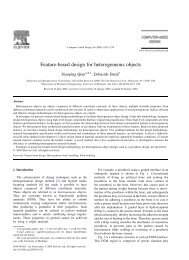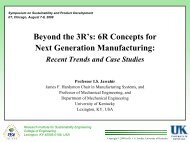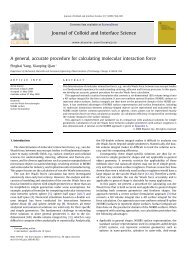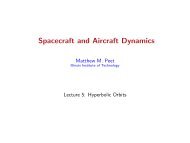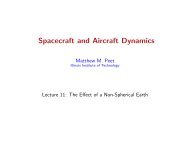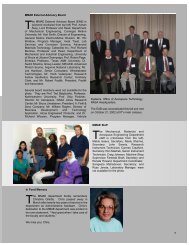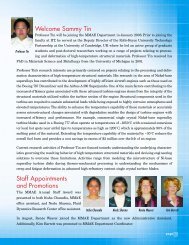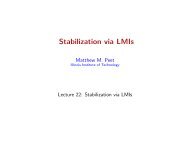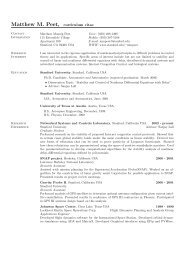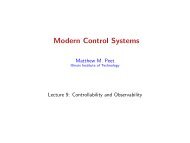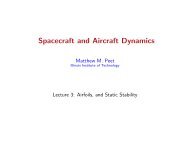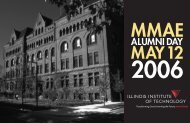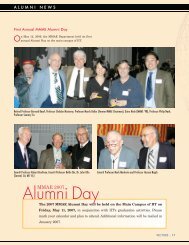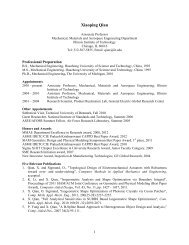1926â1997 Chicago, Illinois Robert Eubanks - Mechanical ...
1926â1997 Chicago, Illinois Robert Eubanks - Mechanical ...
1926â1997 Chicago, Illinois Robert Eubanks - Mechanical ...
You also want an ePaper? Increase the reach of your titles
YUMPU automatically turns print PDFs into web optimized ePapers that Google loves.
Non-Profit Org.<br />
U.S. Postage<br />
PAID<br />
<strong>Chicago</strong>, IL<br />
Permit No. 936<br />
<strong>Mechanical</strong>, Materials, and<br />
Aerospace Engineering Department<br />
10 West 32nd Street, E1-243<br />
<strong>Chicago</strong>, IL 60616<br />
312.567.3175<br />
http://mmae.iit.edu<br />
Vectors Volume 8<br />
The images on the cover show IIT Professor Kevin Cassel’s computational fluid dynamics simulations. The top<br />
figure shows an unsteady separating flow that occurs, for example, on the wing of an aircraft during rapid<br />
flight maneuvers. The bottom figure illustrates the evolution of a gravity current that results from the propagation<br />
of hot smoke and gases in a fire or when cold seawater flows beneath warmer water on the ocean’s floor.
ILLINOIS INSTITUTE OF TECHNOLOGY<br />
MMAE VECTORS MAGAZINE<br />
NOVEMBER 2004<br />
MECHANICAL, MATERIALS, AND<br />
AEROSPACE ENGINEERING<br />
DEPARTMENT
The images on the inside front and back cover show a computational<br />
fluid dynamics simulation performed by Professor Kevin Cassel.<br />
The simulation tracks the fluid flow and heat transfer in a liquid<br />
hydrogen absorber for muon beam cooling, which will be used<br />
in a next-generation high-energy particle physics facility currently<br />
under development with the Fermi National Accelerator Laboratory.
message<br />
from the chair<br />
Iam happy to report that despite restrictions on U.S. visas, the<br />
<strong>Mechanical</strong>, Materials, and Aerospace Engineering Department<br />
welcomed more international students this fall than in previous years.<br />
We also welcomed 72 new freshman this year; a continuous increase<br />
since 2002 (see page 18).<br />
Our faculty members continue to actively conduct research, win<br />
research awards, and publish technical papers in highly reputable<br />
journals—all while motivating students with inspired teaching. Xiaoping Qian, an<br />
expert in computer-aided design and manufacturing, joined our faculty this year, and<br />
we will be hiring a specialist in materials and manufacturing next year.<br />
We have changed the name of the Metallurgical and Materials Engineering program<br />
to Materials Science and Engineering, reflecting trends in the field. MMAE is taking<br />
the lead in a manufacturing initiative that will involve universities across the United<br />
States (see page 19).<br />
We are creating an online program which will enable international students to<br />
earn a master’s of engineering degree—with a specialty in manufacturing—from their<br />
home countries. Of course, domestic students will also be able to take advantage of this<br />
online program.<br />
The next few years will be important ones for the department. To ensure that our laboratories<br />
remain state-of-the-art, we need to raise $300,000 per laboratory as capital<br />
investment and $1 million as endowment. The capital investment will allow us to<br />
purchase new equipment and renovate laboratory space. The endowment will provide<br />
funds for yearly maintenance, upgrades, and support for dedicated teaching assistants.<br />
There are opportunities for naming these laboratories after generous donors.<br />
With your help, we will achieve our goals and continue to make our graduates among<br />
the best educated in the world. Whether you are a former or current student or industry<br />
professional, please do not hesitate to contact us (see page 24). Tell us about your<br />
successes. We want to hear from you.<br />
Jamal Yagoobi<br />
yagoobi@iit.edu<br />
312.567.3239
esearch<br />
Professor Kevin Cassel<br />
Professor Cassel’s research is focused on bringing the latest in analytical and<br />
computational techniques to bear on the thermo-fluid sciences. His research, as<br />
he describes it, involves “computational fluid dynamics in conjunction with<br />
advanced analytical methods to address problems in unsteady aerodynamics<br />
and cryogenic fluid flow and heat transfer.” His work in unsteady aerodynamics<br />
has been funded by the Army Research Office, published in several professional<br />
journals, and presented at the London Mathematical Society Workshop on New<br />
Developments and Applications of Rapid Fluid Flows in Durham, United<br />
Kingdom. Cassel says this research is “aimed at developing a better understanding<br />
of the highly transitory events that occur when an airfoil or helicopter rotor<br />
is pitched up rapidly.”<br />
His research in cryogenic fluid flow and heat transfer—funded by the U.S.<br />
Department of Energy, the Fermi National Accelerator Laboratory, and the<br />
<strong>Illinois</strong> Consortium for Accelerator Research—concerns the design of a liquid<br />
hydrogen absorber for muon beam cooling. In the summer of 2003, Cassel<br />
was a Research Fellow at University College London.<br />
Lecturer Dr. John Cesarone<br />
Cesarone’s research focuses on manufacturing engineering, specifically<br />
computer-integrated manufacturing technologies, simulation and functional<br />
modeling methodologies, optimization using operations research techniques,<br />
automation and robotics, and distance learning.<br />
page 2
Professor Herek Clack<br />
Professor Clack received a five-year Faculty Early Career Development<br />
(CAREER) Award from the National Science Foundation (NSF) this year.<br />
According to the NSF, CAREER awards recognize “teacher-scholars who<br />
are most likely to become the academic leaders of the 21st century.” He was<br />
also selected to serve on a National Research Council committee to assess the environmental,<br />
economic, and health impacts of recent changes to the New Source<br />
Review (NSR) program, a key element of the Clean Air Act. Chartered<br />
by Congress and funded by the Environmental Protection Agency, the committee<br />
will hear testimony from representatives of government agencies, industry, and<br />
environmental advocacy groups. The committee’s final report, to be released<br />
in 2006, is expected to be the definitive study on the impacts of changes to<br />
the NSR program.<br />
One of Clack’s research projects seeks to “identify anomalous transport phenomena<br />
affecting the vaporization of fuel droplets during spray combustion at<br />
reduced scales.” To do this, he and his research team will build a flow reactor<br />
designed specifically to induce the anomalous droplet behavior. Planar laserinduced<br />
fluorescence imaging<br />
will provide images of the fuel<br />
vapor concentration around<br />
each droplet as it vaporizes.<br />
Clack’s research projects will<br />
involve teams of “Engineering<br />
Collectives.” The collectives<br />
consist of IIT graduate and<br />
undergraduate students, along<br />
with select local high school<br />
juniors and seniors—who will<br />
work on year-long, largely selfdirected<br />
research projects of<br />
Liquid nitrogen is used to cool infrared detectors that measure part per million concentrations of chemical species.<br />
their choosing.<br />
page 3
Professor Michael Gosz<br />
If an aircraft has a crack on the skin of its fuselage—say, a small crack emanating<br />
from a rivet hole—does the fuselage need to be repaired immediately or can<br />
it wait? To answer that question, one must be able to predict whether the crack<br />
will grow. To help predict the lifespan of a particular structural component,<br />
Professor Gosz uses numerical techniques to determine what are called “stress<br />
intensity factors.”<br />
Stress intensity factors are a measure of how quickly the stress increases as one<br />
gets very close to the tip of the crack. Knowledge of these parameters allows the<br />
engineer to determine whether a crack of a particular length will grow under a<br />
certain set of loading conditions. “Many structures with cracks still have a useful<br />
life,” says Gosz, who is the MMAE Associate Chair for Graduate Programs.<br />
Gosz and researchers at the University of <strong>Illinois</strong>’ <strong>Chicago</strong> and Argonne National<br />
Laboratory will be working on a grant funded by the National Institutes of<br />
Health to design improved dental materials. Gosz will use numerical techniques<br />
to study how the distribution and size of filler particles affect the performance<br />
and failure of these materials. Gosz is writing a book, Learning the Finite<br />
Element Method: Applications in Solids, Structures and Heat Transfer, to be<br />
published in 2006.<br />
Professor John Kallend<br />
Professor Kallend serves as the MMAE Associate Chair for Undergraduate<br />
Programs, Associate Dean for Accreditation and Assessment, as well as<br />
University Head Marshal. His research focuses on the structure and properties<br />
of polycrystalline materials. Kallend has received several teaching awards.<br />
Professor Kevin Meade<br />
For his work in biomechanics, elasticity, and fracture mechanics, Professor Meade<br />
has received several awards. He spent five months of his recent sabbatical leave<br />
in Bogota, Colombia working at Laboratorio Gilete. During his stay in Colombia,<br />
Meade presented 22 invited talks at a number of institutions, including the<br />
National University, Central Military Hospital, and Central Police Hospital.<br />
Professor Meade also helped work to establish the first school of orthotics and<br />
prosthetics in Colombia. The school will open in January 2005.<br />
page 4
Professor Sheldon Mostovoy<br />
Professor Mostovoy performs research on the mechanical properties of materials,<br />
especially fatigue and fracture. He evaluates fracture and fatigue testing and test<br />
methods, analyzes service failures, and studies the relationship of fatigue and<br />
fracture. At Argonne National Laboratory, Mostovoy is designing a 100-element,<br />
lithium-lens system for focusing X-rays at the Advanced Photon Source.<br />
Professor Hassan Nagib<br />
Nagib, the John T. Rettaliata Distinguished Professor of <strong>Mechanical</strong> and<br />
Aerospace Engineering, is a pioneer in the management, manipulation, and<br />
control of turbulent and separated flows. His current activities—funded by the<br />
U.S. Air Force, NASA, Boeing, and DARPA—include research aimed at reduced<br />
fuel consumption of large aircraft and improved wind tunnels/flow facilities.<br />
His research also involves, he says,<br />
Members of Nagib’s group testing a Boeing active-flow enabled refueling-boom model in the NDF wind tunnel<br />
“download alleviation on tilt-rotor<br />
airplanes like the Osprey V22;<br />
active-flow-empowered simple airfoil<br />
flaps that can be made as good as, or<br />
better than, more complex high-lift<br />
flap systems for military and<br />
commercial aircraft; and simpler<br />
and lighter weight refueling booms<br />
for a global military force.”<br />
Nagib studies high Reynolds number turbulence and measured surface resistance<br />
to such flows, ranging from transport aircraft to ducts. His research team<br />
hopes to resolve issues that aircraft manufacturers face—issues that have<br />
remained in dispute for many decades. A Fellow of the American Physical Society<br />
and the American Association for the Advancement of Science, Nagib has organized<br />
a number of international meetings and workshops, including the Second<br />
International Workshop on Wall-Bounded Turbulent Flows at the Center for<br />
Theoretical Physics in Trieste, Italy. Nagib’s work has been recognized by a<br />
number of awards, including NASA’s Langley Achievement Award and the<br />
ASME’s Knapp award, which recognizes “an outstanding original paper.”<br />
page 5
Scanning electron microscope in use<br />
Professor Sudhakar Nair<br />
Professor Nair, a Fellow of the ASME, has always been interested in structural<br />
mechanics. Nair seeks solutions for static and dynamic behavior of deformable<br />
bodies using analytical as well as numerical methods. His recent research, he<br />
says, involved the “elastic waves in anisotropic materials, force-deflection relations<br />
for nano-composites with aluminum matrix and silicon carbide fibers, and<br />
moving boundary programs of the Stefan type.” In a joint project with the<br />
Argonne National Laboratory, Nair is involved in the study of silicon mirrors in<br />
deflecting high-energy X-ray beams. Appropriate cooling of the anisotropic<br />
mirror to reduce the heat-induced curvature is a challenge in this study. He is<br />
also collaborating with Professor Gosz in designing an electro-magnetic cooling<br />
chamber for muon beams at the Fermi National Laboratory. Nair is the Associate<br />
Dean for Academic Affairs for IIT’s Graduate College. As such, he oversees the<br />
progress of more than 2,500 IIT graduate students.<br />
Professor Philip Nash<br />
Professor Nash is director of IIT’s Thermal Processing Technology Center,<br />
a resource for industry professionals who want to conduct research with state-ofthe-art<br />
equipment, including modeling and simulation software. This year, the<br />
Center welcomed four new industry members—Engineered Materials Solutions,<br />
MAGMA, Penn Aluminum, and<br />
International Titanium Powder—<br />
and recently received funding<br />
from the National Science<br />
Foundation and Northrup<br />
Grumman. The Center has nine<br />
member companies. The Center<br />
also welcomed two new Research<br />
Assistant Professors Dajun Chen<br />
and Zhiyong Hu. Professor Chen,<br />
an expert in electron microscopy<br />
and phase transformations,<br />
directs the electron microscopy<br />
laboratories. Professor Hu, an<br />
expert in computational materials science, is responsible for software and<br />
computer systems.<br />
page 6
The Center added two major research projects over the last year: one involves the<br />
development of silver alloy electrical contacts; the other is a study of bainite<br />
transformation kinetics in carburized steel.<br />
In the coming year, the<br />
Center will continue its<br />
work on alloy development<br />
and materials<br />
processing for Ag, Ni, Fe<br />
and Ti alloys, and hopes<br />
to add projects in Ti<br />
powder metallurgy, cryogenic<br />
processing, and<br />
phase field modeling.<br />
If you are interested<br />
in exploring how the<br />
Center can help your<br />
company, please contact<br />
Nash at nash@iit.edu or<br />
visit the Center’s web<br />
site: http://tptc.iit.edu.<br />
Students working with the Gleeble machine<br />
Professor Boris Pervan<br />
Using satellite-based global positioning systems (GPS), Professor Pervan helps<br />
airplane pilots figure out where they are, where they want to go, and how to get<br />
there—in zero visibility conditions. Accuracy can be a matter of life and death.<br />
Standard GPS, using a constellation of 24 satellites, provides accuracy within<br />
about ten meters. Pervan and his colleagues use differential GPS to narrow the<br />
margin of error to one meter. In fact, to land airplanes on aircraft carriers—<br />
which are also moving—sub-meter accuracy is needed. Because there is no<br />
opportunity for trial-and-error under these circumstances, Pervan and his<br />
colleagues are developing advanced algorithms to reduce the possibility of error<br />
to a one-in-one-billion chance.<br />
page 7
He also uses GPS to control autonomous ground<br />
vehicles. So far, he has achieved accuracy to within<br />
five centimeters. Pervan supervises a team of<br />
students who built what they call an “autonomous<br />
lawnmower,” which cuts grass, but more importantly<br />
actually is a prototype for a vehicle that<br />
could be used to sweep a field for land mines.<br />
“If you’re looking for land mines, you don’t want to<br />
miss any,” he says. Because trees can get in the<br />
way of satellite signals, to ensure the satellite<br />
signal reaches a ground vehicle underneath tree<br />
cover, he is developing a network of “robotic relay<br />
mechanisms.”<br />
GPS-guided robotic vehicle<br />
Pervan won the M. Barry Carlton Award from the<br />
IEEE Aerospace and Electronic Systems Society<br />
for the paper, “Autonomous Fault Detection and<br />
Removal Using GPS Carrier Phase,” and the<br />
William E. Jackson Award from the Radio<br />
Technical Committee on Aeronautics for “outstanding contribution to aviation.”<br />
He is an associate editor for the quarterly journal Navigation.<br />
Professor Xiaoping Qian<br />
Professor Xiaoping Qian’s work focuses on computer-aided design and manufacturing.<br />
To ensure manufactured parts meet design specifications, he has been<br />
developing laser-scanning technologies to digitally acquire complex three-dimensional<br />
shapes for quality inspection. His research also involves what is called<br />
“reverse engineering”—taking a part that was not designed on a computer or<br />
came from a third party, scanning it in, and coming up with the original design<br />
in the computer. Another aspect of Qian’s research involves modeling threedimensional<br />
parts of non-homogeneous materials. “If I want to make something<br />
of complex shape or of multiple materials, I first model it with a computer,” he<br />
says. “After I model it, I will be able to fabricate it using a new layered manufacturing<br />
process.” Before coming to IIT this year, Qian was a research scientist at<br />
General Electric’s Global Research Center in Niskayuna, N.Y. In 2004, he was<br />
named a “New Innovator” in GE’s Global Research Inspection and<br />
Manufacturing Technologies Lab.<br />
page 8
Professor Ganesh Raman<br />
Professor Raman’s research interests are high speed flows, flow control, and experimental<br />
aeroacoustics. Under certain conditions, imperfectly expanded jet plumes<br />
produce a discrete tone, referred to as “screech,” says Raman. “This discrete<br />
component of jet noise,” he says, “occurs in addition to broadband shock noise and<br />
jet mixing noise. The jet screech problem provides a unique setting for<br />
researchers working in any of the following areas: instability wave dynamics in<br />
supersonic flows, shock-instability wave interaction, modes of feedback in resonant<br />
flow, and receptivity processes occurring in the vicinity of the nozzle exit.”<br />
According to Raman, “the knowledge gained during the study of screech applies<br />
to a variety of resonant flow situations, including jet impingement, cavity resonance,<br />
and closed-loop active control. Jet plumes from aircraft exhaust can couple<br />
unpredictably, resulting in sonic fatigue failure of aircraft structures.”<br />
Raman’s research team at IIT recently<br />
concluded a project funded by the U.S. Air<br />
Force on the interaction of twin jets<br />
of complex geometry. Results from this<br />
study, Raman says, will be useful to nozzle<br />
designers and engineers who work on<br />
“active flow control systems to prevent<br />
harmful resonant coupling.” Before coming<br />
to IIT, he spent 14 years at NASA’s John<br />
Glenn Research Center. He is the editor<br />
of the International Journal of Aeroacoustics<br />
and a Fellow of the ASME.<br />
Twin supersonic jet coupling<br />
Professor Dietmar Rempfer<br />
Professor Rempfer’s research interests are primarily in fluid dynamics<br />
and turbulence, dynamical systems theory, and numerical methods. He says<br />
he is “attempting to achieve a more complete understanding of wall-generated<br />
turbulence using analysis, computation, and experimentation.” Rempfer uses<br />
supercomputers to create direct numerical simulations of several types<br />
of “transitional flows.” The techniques used in these simulations include<br />
finite-difference, finite-element, and spectral methods.<br />
page 9
He is also interested in the construction and specific properties of “low-dimensional<br />
models for the dynamics of complex flows,” he says. “These models are<br />
constructed by Galerkin projections onto suitable function bases, like wavelet<br />
bases, and Karhunen-Loeve eigenfunctions.” The behavior of such models<br />
is then analyzed using tools from dynamical systems theory. In addition<br />
to achieving a more complete understanding of wall-generated turbulence,<br />
Rempfer hopes to construct better models for engineering calculations of<br />
turbulent flows and to devise techniques and strategies for “active control<br />
of turbulent boundary<br />
layers.” He directs a new<br />
research group that will,<br />
he says, “investigate novel<br />
methods for an optimal<br />
solution of the direct and<br />
inverse problems of biocontaminant<br />
dispersion<br />
in a metropolitan area.”<br />
This area of research is supported by the federal government, which funds<br />
research relevant to homeland security.<br />
The figure shows the 3-D structures that develop during turbulence in pipe flow. The image was obtained from a numerical simulation<br />
of the full, 3-D Navier-Stokes equations.<br />
Professor Francisco Ruiz<br />
To burn fuel, one must first atomize it into very fine drops. In an automobile<br />
engine, this is achieved by injecting the fuel at high pressure through tiny holes.<br />
The fuel breaks up within a few thousandths of a second. To discover how to burn<br />
fuel in the fastest, most efficient way possible, Professor Ruiz studies the fundamental<br />
mechanisms of atomization. “To this day, it’s not well understood why the<br />
liquid breaks up into a spray instead of just squirting out,” says Ruiz. “And it’s<br />
very difficult to measure.”<br />
He is also studying what happens when different types of fuel are used. His<br />
research involves the use of ethanol to fuel many types of vehicles—from automobiles<br />
to ultralight airplanes. He founded the IIT Ultralight Flying Club, which<br />
uses an ethanol-burning airplane. (<strong>Illinois</strong> is the biggest producer of ethanol in<br />
the country.) Ruiz is building what is called a “regenerative engine,” one that he<br />
says “harnesses energy normally dispersed through the exhaust system and puts<br />
it back into the cycle.”<br />
page 10
He has built two regenerative engine prototypes<br />
and is working on a third. “It will<br />
increase efficiency and reduce the amount of<br />
exhaust pollutants as well,” he says. Ruiz<br />
developed a curriculum to teach engineers<br />
to be inventors. His curriculum was adopted<br />
as part of IIT’s Jules F. Knapp Center for<br />
Entrepreneurial Studies. Ruiz is part of<br />
a research team investigating the enhancement<br />
of infrared emission for heating and<br />
drying of moist materials. His honors include<br />
the Tanasawa Award, an award given to just<br />
one or two people per year.<br />
Professor Murat Vural<br />
Infrared emission study for heating and drying of moist materials<br />
“One of the key ways to understand different materials is to subject them<br />
to different external stimuli and watch their responses,” says Professor Vural,<br />
whose research interests center on the mechanics of materials—particularly<br />
those pertaining to their dynamic behavior. In many engineering processes—<br />
such as those in high-speed machining, ballistic penetration, impact, and crash<br />
of vehicles—materials are subjected to extremely high deformation rates, which<br />
are 1 to 100 million times higher than in typical laboratory experiments. As one<br />
might guess, once the rate of loading (i.e., the stimulus) becomes too high, the<br />
response of materials dramatically changes and gets more complicated. Although<br />
challenging, understanding and mathematically modeling high-strain-rate<br />
behavior and failure of materials are not only essential for the analysis<br />
of these high rate deformation processes, but also help us develop new design<br />
strategies. The goal is to use materials in the most efficient and reliable way for<br />
specific applications. Vural’s research group employs specially designed equipment<br />
like Hopkinson pressure bars and single-stage gas guns to generate<br />
controlled dynamic loading conditions that typically last from 10 to 100 microseconds.<br />
In this relatively small time frame, the material’s response is measured<br />
using state-of-the-art, high-speed diagnostic tools such as resistive and piezoelectric<br />
transducers, infrared optics and detectors, and high speed data acquisition<br />
systems. Numerical modeling and material characterization are integral parts of<br />
these experiments. Materials investigated in Vural’s studies cover a wide range<br />
and include metals and alloys, fiber-reinforced composites, and cellular solids<br />
such as metal foams.<br />
page 11
Professor Candace Wark<br />
Professor Wark, who has been on the faculty at IIT for 16 years, focuses her<br />
research in the area of turbulence. When air or water flows along a vehicle’s<br />
surface, the flow adjacent to the surface is usually turbulent. The objective of the<br />
research is to understand the “physics” of the flow in an effort to optimize the<br />
vehicle’s performance. Because we are not able to predict the flow around an<br />
object, engineers are left to model the flow. Research concentrating on the<br />
“physics” of the flow will help to build a better model. The more we understand<br />
about the flow, the better the model will be. Wark is also part of a research team<br />
investigating the dispersion of biocontaminants in a metropolitan area.<br />
Students work with transonic axial cascade<br />
Wark is the Associate Dean of the Armour College of Engineering, where she<br />
is working on a major overhaul of the undergraduate and graduate engineering<br />
curricula to give them a multidisciplinary approach. “This has come about<br />
because so many students (and alumni) start in one engineering field, but end<br />
up working in another,” she says. “A multidisciplinary education will help<br />
students apply the fundamentals to a broader range of applications.”<br />
Professor David Williams<br />
Professor Williams, director of the Fluid Dynamics<br />
Research Center, explores better ways to control and<br />
measure the flow of liquids and gases in everything<br />
from jet engines to natural gas into homes. One<br />
practical application of controlling flow is to develop<br />
more efficient aircraft engines. Williams’ research<br />
with Honeywell and NASA’s John Glenn has shown<br />
that “by introducing disturbances at the right point<br />
and at the right frequency, you can prevent compressor<br />
stall.” This, in turn, increases the engines’<br />
performance and efficiency, and makes it possible for<br />
engines to be shorter, lighter, and smaller. During<br />
the past four years, he has worked closely with<br />
Honeywell to develop “Smart Vanes” for improved<br />
aircraft engine performance. With engineers from<br />
Honeywell, Williams has also been creating highamplitude<br />
pressure fluctuations in tubes and actuators, devices that put energy<br />
into a flow for control purposes.<br />
page 12
Two-phase flow distribution with EHD pumping<br />
He continues to do work for the U.S. Air Force in measuring and controlling<br />
the noise emanating from cavities—such as wheel wells and weapons bays—<br />
in aircraft. Under typical flight conditions, the sound pressure level can hit 170<br />
decibels, which can cause structural damage. In addition to his work in wind<br />
tunnels at IIT, Williams conducts experiments at the U.S. Air Force Academy and<br />
at Princeton University. “Our goal is to develop a feedback system to dampen the<br />
large-amplitude tones,” he says. Williams’ work in flow metering focuses on<br />
spirometers, which measure lung performance in asthma patients, and fluidic<br />
oscillators, which can be used as natural gas meters for homes. Williams, who has<br />
received a number of awards for his research, is an Associate Fellow of the<br />
American Institute of Aeronautics and Astronautics.<br />
Professor Jamal Yagoobi<br />
Professor Yagoobi’s research expertise is enhancement of heat transfer<br />
and mass transport, transport phenomena in porous media, and innovative<br />
impinging jets. Using electrohydrodynamic (EHD) mechanisms,<br />
he is investigating augmentation of heat transfer and pumping of<br />
liquid film during the phase change (liquid/vapor) in the presence and<br />
absence of gravity in macro and micro scales.<br />
Because non-mechanical transport devices are useful in space—due to the lack<br />
of vibration and low maintenance requirements—most of Yagoobi’s work in this<br />
area is supported by NASA. His research in porous media focuses on drying of<br />
moist porous materials—such as pulp and paper—with an<br />
emphasis on radiative methods such as infrared emitters.<br />
Yagoobi and a colleague at Texas A&M University have developed<br />
unique nozzles, including the “Radial Jet Reattachment”<br />
nozzle, “Slot Jet Reattachment” nozzle, and “Radial Jet<br />
Reattachment Combustion” nozzle. These nozzles allow for<br />
superior heat transfer—with minimal flow exerted force—on<br />
delicate materials to be dried, heated, or cooled. Yagoobi’s<br />
research in all of the above areas has resulted in a number of<br />
patents that have been licensed to various companies. An ASME Fellow, Yagoobi<br />
has received a number of awards for his teaching and research, including the Pi<br />
Tau Sigma/ASME Gustus L. Larson Memorial Award for outstanding achievements<br />
in mechanical engineering within 10 to 20 years after graduation. This<br />
year, he received the inaugural IEEE Electrostatic Processes Committee’s<br />
Innovation and Creativity Paper Award for his work in EHD pumping of dielectric<br />
fluids based on fluid molecules dissociation/recombination phenomenon. He is<br />
currently on the advisory board of several international journals and conferences.<br />
EHD pumping of micro liquid film during phase change<br />
page 13
GPS Systems Steer<br />
Vehicles that<br />
Detect Land Mines<br />
Many homeowners have wished that their lawnmower could<br />
cut the grass on its own. Using global positioning system (GPS)<br />
technology, graduate student Mathieu Joerger and<br />
a team of students in IIT’s Navigation and Guidance<br />
Lab have built one. They entered the vehicle, which<br />
they’ve affectionately named “Leonard,” in the Institute<br />
of Navigation’s Autonomous Lawn Mower Competition<br />
in Dayton, Ohio, this summer and finished in third place.<br />
In addition to guiding lawnmowers, GPS-based technology is<br />
used to steer vehicles that detect land mines.<br />
Joerger holds two master’s degrees, one in mechanical and<br />
aerospace engineering from IIT; the other from the Ensais<br />
Engineering School in his native France.<br />
page 14
Wheeler Investigates<br />
Space Shuttle<br />
Columbia Disaster<br />
Reinforced carbon carbon (RCC) was used for the wings and<br />
nose of the space shuttle Columbia, the aircraft that failed and<br />
burned upon re-entry to the earth’s atmosphere. IIT Senior Jeff<br />
Wheeler’s work at Argonne National Laboratory includes<br />
assessing the condition of RCC<br />
panels. Using an ultrasonic sensor,<br />
Wheeler and his colleagues measured<br />
defects in the surface of RCC<br />
panels. “We got very, very good<br />
data,” he said.<br />
Wheeler is also involved in water-coupled ultrasound in which<br />
samples are immersed in water and “pulled through” to detect<br />
minute flaws. This method is used to test “anti-armor piercing<br />
tiles” for tanks. Wheeler received the Carl Samans Scholarship<br />
from the <strong>Chicago</strong> chapter of ASM in February.<br />
page 15
Working with NASA<br />
on New Forms of Fuel<br />
An IIT Junior majoring in aerospace engineering and applied<br />
mathematics, Marta Bastrzyk spent this past summer working for<br />
NASA’s John Glenn Research Center in Cleveland. Her internship<br />
focused on a project dealing with solid oxide fuel<br />
cells and the seals needed to prevent fuel leaks. Used<br />
in conventional combustion systems, solid oxide fuel<br />
cells create 400 percent less pollution and work more<br />
efficiently, says Bastrzyk. Used in hybrid automobiles,<br />
the fuel cells can increase a car’s efficiency by 60 percent.<br />
The fuel cells are also used in unmanned aerial vehicles and as<br />
auxiliary power for electrical aircraft like the Boeing 7E7.<br />
page 16
Casas Helps<br />
Rolls Royce to Fly<br />
Senior Guillermo Casas works with a team that provides<br />
technical support to a line of Rolls Royce engines that provide<br />
power for civil transport airplanes—the Embraer 145 and<br />
Cessna Citation X. He hopes to improve certain performance<br />
issues, including fuel consumption and ground speed.<br />
A native of Colombia, Casas is majoring in aerospace<br />
and mechanical engineering. He is president<br />
of IIT’s chapter of the Society of Hispanic Professional<br />
Engineers, and is also active in Latinos Involved in<br />
Further Education. Casas hopes to work for an aerospace<br />
company in the U.S. after graduation.<br />
page 17
news<br />
Department Experiences<br />
Continuous Increase<br />
in Enrollment<br />
The graduate and undergraduate programs have<br />
experienced continuous increases during the past few<br />
years. The department welcomed 93 new graduate<br />
students, up from 68 in 2002, resulting in 176 full-time<br />
graduate students. The undergraduate program grew<br />
from 247 students in 2002 to 276 students this year.<br />
MMAE Total<br />
Undergraduate<br />
Enrollment<br />
2002<br />
247<br />
2003<br />
261<br />
2004<br />
276<br />
Freshmen Enrollment<br />
New Graduate Enrollment<br />
2002<br />
64<br />
2003<br />
68<br />
2004<br />
72<br />
2003<br />
83<br />
2004<br />
93<br />
2002<br />
68<br />
MMAE Develops<br />
State-of-the-Art<br />
Teaching<br />
Laboratories<br />
The MMAE Department is<br />
constantly striving to improve<br />
the undergraduate teaching<br />
labs by introducing cutting-edge<br />
facilities. For example, undergraduate<br />
students learn how<br />
to use particle image velocimetry<br />
technique to measure flow<br />
fields in the fluid mechanics<br />
labs. To measure an individual’s<br />
temperature while he/she is<br />
exercising, students use infrared<br />
thermography.<br />
page 18
Fear and Joseph Win MMAE Alumni Awards<br />
Two MMAE alumni, Geoffrey Fear and Daniel Joseph, were recognized<br />
for outstanding achievement in the field of mechanical engineering. Fear<br />
is Chairman of the Board of <strong>Chicago</strong> Metallic Products, Inc.,<br />
a company that manufactures and sells metal bakeware, aluminum<br />
foil, and plastic packaging materials. A 1951 graduate of IIT, Fear<br />
established the Fear Endowed Fellowship (with matching funds<br />
from <strong>Robert</strong> Pritzker and <strong>Robert</strong> Galvin) in 1999 for top students<br />
pursuing a master’s degree in MMAE at IIT. Daniel D. Joseph<br />
is the Regents Professor of the Aerospace Engineering and<br />
Geoffrey Fear Mechanics Department at the University of Minnesota. A member<br />
of the National Academy of Sciences and the National Academy<br />
of Engineering, Joseph was awarded the American Society of <strong>Mechanical</strong><br />
Engineers’ Timoshenko Medal for his contributions to the field of applied<br />
mechanics. Joseph earned three degrees at IIT: a bachelor of science (’59),<br />
Daniel Joseph<br />
a master of science (’60), and a doctorate (’63).<br />
IIT to Establish Center for<br />
Manufacturing Research<br />
MMAE is leading the IIT Armour College of Engineering initiative in manufacturing.<br />
IIT will work with other universities nationwide, U.S. companies, and national<br />
laboratories to establish a manufacturing center for scientific and applied research.<br />
The Center will ensure that manufacturing industries in the United States will<br />
have cutting-edge technology and will lead the world in manufacturing. The<br />
proposed Center will also collect, analyze, synthesize, and disseminate scientific and<br />
technical discoveries worldwide for the benefit of U.S. manufacturing companies.<br />
Qian Joins MMAE Department<br />
Xiaoping Qian came to IIT from General Electric’s Global<br />
Research Center in Niskayuna, N.Y., where he was<br />
named a “New Innovator” in the Inspection and<br />
Manufacturing Technologies Lab. A PhD graduate from<br />
the University of Michigan, he is an assistant professor of<br />
mechanical engineering. Qian’s research interests are<br />
focused on computer-aided design and manufacturing.<br />
To ensure manufactured parts meet design specifications,<br />
he has been developing laser-scanning technologies<br />
to acquire complex three-dimensional digital images<br />
for quality inspection. He also models 3-D parts of nonhomogeneous<br />
materials.<br />
page 19
Candace Wark<br />
MMAE Faculty Receive Awards<br />
for Teaching and Research<br />
John Kallend received the IIT Bauer Family Undergraduate<br />
Teaching Award. Candace Wark received the MMAE Ralph L.<br />
Barnett Excellence in Teaching Award. Philip Nash was the<br />
recipient of IIT’s Sigma Xi Award for excellence in research.<br />
Herek Clack received the prestigious National Science<br />
Foundation CAREER Award. Ganesh Raman was named<br />
Fellow of the American Society of <strong>Mechanical</strong> Engineers.<br />
Jamal Yagoobi received the inaugural IEEE Electrostatics<br />
Processes Committee Innovative and Creativity Prize Paper<br />
Award. Dietmar Rempfer received tenure.<br />
Herek Clack<br />
MMAE Department Advisory Board<br />
First row, left to right: Ganesh Raman, Hamid Arastoopour, Jamal Yagoobi, David Williams, John Kallend<br />
Second row, left to right: James Korenchen (General Motors), <strong>Robert</strong> Footlik (Footlik & Assoc.), Ted Belytschko (Northwestern University), Philip Nash, Francisco Ruiz,<br />
Geoffrey Fear (<strong>Chicago</strong> Metal. Prod., Inc.), Dietmar Rempfer<br />
Third row, left to right: Daniel Joseph (University of Minnesota), Adnan Akay (Carnegie Mellon University), <strong>Robert</strong> Page (Texas A&M), Sushil Sharma<br />
(Argonne National Lab.) Ric Woldow (Caterpillar, Inc.), Candace Wark, Michael Gosz, Sheldon Mostovoy, Sudhakar Nair<br />
Advisory Board members not pictured are John Berninger (Advanced Anaylsis Engineering), Skip Fletcher (NASA), Les Hardison (Wheelabrator Tech.),<br />
Bruce Liimatainen (A. Finkl & Sons, Inc.), Herb Velazquez (Kimberly Clark), Richard Wlezien (NASA).<br />
page 20
Chen, Parsons, Alsharo’a Win Poster Competition<br />
Graduate and undergraduate<br />
students participated in a research<br />
poster competition hosted by the<br />
MMAE department in April. Nearly<br />
$1,000 in prize money was awarded<br />
by a panel of industry professionals.<br />
The criteria included innovative<br />
research, the presentation of the<br />
material, and overall impact. Listed<br />
below are the winners by category:<br />
Zheyan Chen (bachelor’s degree<br />
candidate—first place); Mayuri<br />
Amarnath (bachelor’s degree candidate—second<br />
place); Abigail Parsons<br />
Mayuri Amarnath<br />
(master’s degree candidate—first<br />
place); Taehyung Kim (master’s degree candidate—second place); Mohammed<br />
Alsharo’a (doctoral degree candidate—first place); and Mathieu Joerger (doctoral<br />
degree candidate—second place).<br />
Dix Retires<br />
After 40 years at IIT, Professor Rollin Dix retired this year.<br />
After brief stints in the army and working in industry,<br />
he came to IIT in 1964 as an assistant professor of mechanical<br />
engineering, and taught both mechanical and aerospace<br />
engineering. His research focused on computer-aided design<br />
and manufacturing, mechanical design and materials<br />
handling, and automated materials handling equipment.<br />
A Fellow of the American Society of <strong>Mechanical</strong> Engineers,<br />
Dix is listed in Who’s Who in America.<br />
Torda Dies at 92<br />
Professor of <strong>Mechanical</strong> Engineering T. Paul Torda passed<br />
away in Washington, D.C., in March. He was 92. Torda, who<br />
joined the IIT faculty in 1962 and retired in 1976, was faculty<br />
advisor for the IIT team that designed the “Blue Flame,”<br />
a rocket-powered vehicle that set a 1970 land speed world<br />
record of more than 622 miles per hour. He also helped design the Experimental<br />
Engineering Education program at IIT, a project-based undergraduate program<br />
funded by the National Science Foundation.<br />
page 21
history<br />
This<br />
is the first in a series on the department’s history.<br />
Eli Sternberg<br />
1917–1988 Vienna, Austria<br />
Eli Sternberg is known worldwide for his pioneering research in the<br />
theory of structural elasticity. His theoretical research found many applications<br />
in both mechanical and civil engineering. He began his teaching<br />
career in 1945, serving as an IIT faculty member for 11 years. Sternberg<br />
earned both a master’s degree (1942) and a PhD (1945) in mechanics at<br />
IIT. He was a member of the National Academy of Science.<br />
Max Jakob<br />
1879–1955 Ludwigshaven, Germany<br />
Max Jakob was an authority on thermodynamics and heat transfer.<br />
His extensive research covered high-pressure stream and air, measurement<br />
of thermal conductivity, mechanisms of boiling and condensation, and flow<br />
in pipes and nozzles. Jakob came to <strong>Chicago</strong> from Germany at the suggestion<br />
of his close friend, Enrico Fermi. Jakob became research professor of<br />
mechanical engineering and a consultant at Armour Research Foundation<br />
(now IITRI). Jakob founded and became the first director of IITRI’s Heat<br />
Transfer Laboratory. In 1961, the American Society of <strong>Mechanical</strong> Engineers<br />
commemorated his achievements by instituting the annual Max Jakob<br />
Memorial Award, which honors distinguished service in heat transfer.<br />
page 22
Max Mark Frocht<br />
1894–1974 Warsaw, Poland<br />
Max Frocht is considered the father of modern photo-elasticity studies.<br />
In the early 1950s, he developed a method of three-dimensional photo-elastic<br />
stress analysis that determined the actual principal stresses at any point within<br />
a body. His two-volume book on photo-elasticity is considered a classic. From<br />
1946 to 1964, the year of his retirement, Frocht was a member of the<br />
IIT faculty. He organized and was director of the Laboratory for Experimental<br />
Stress Analysis, one of the world’s leading research laboratories. In 1967,<br />
the Society for Experimental Stress Analysis (now the Society for<br />
Experimental Mechanics) honored him by establishing the annual<br />
M.M. Frocht Award, which is awarded to the “educator of the year” in<br />
experimental mechanics.<br />
<strong>Robert</strong> Alonzo <strong>Eubanks</strong><br />
1926–1997 <strong>Chicago</strong>, <strong>Illinois</strong><br />
<strong>Robert</strong> <strong>Eubanks</strong>, a three-time IIT alumnus (B.S., mechanical engineering,<br />
1950; M.S., 1951; PhD, 1953), is renowned for his expertise in<br />
elasticity, wave propagation, rotor stability, shock, and vibration. He<br />
joined the IIT faculty briefly in 1954 and returned as a member of<br />
Armour Research Foundation (now IITRI) from 1960 to 1966. <strong>Eubanks</strong> was<br />
a prime mover in the development of minority engineering programs<br />
through his membership on the executive committee of the National<br />
Consortium for Graduate Degrees for Minorities in Engineering. He was<br />
a Fellow of the American Academy of Mechanics and of the American<br />
Society of Civil Engineers.<br />
page 23
alumni news<br />
& contribution card<br />
The <strong>Mechanical</strong>, Materials, and Aerospace Engineering Department sincerely appreciates your gift.<br />
The quality of classroom academics, laboratory research, and faculty growth is directly related to the<br />
generosity of our community of alumni and friends. Donations are tax deductible and can be made in the<br />
form of a check payable to <strong>Illinois</strong> Institute of Technology, a money order, or a credit card payment. Please<br />
return this form to Kim Barrett, MMAE, 10 West 32nd Street, E1-243, <strong>Chicago</strong>, IL 60616.<br />
Donation Amount: $_______________<br />
Credit Card Type: Visa MasterCard<br />
_____________________________________________________________________________________<br />
Name<br />
_____________________________________________________________________________________<br />
Address<br />
_____________________________________________________________________________________<br />
City State Zip<br />
_____________________________________________________________________________________<br />
Phone Number<br />
_____________________________________________________________________________________<br />
Email Address<br />
_____________________________________________________________________________________<br />
Credit Card Number<br />
Expiration Date<br />
_____________________________________________________________________________________<br />
Signature<br />
The department would like to know where our former students are and what they are doing. In the space<br />
below, please fill us in on your news since we last heard from you. Be sure to include your name, degree,<br />
and year of graduation. Alumni updates may be published in our next issue of Vectors.<br />
_____________________________________________________________________________________<br />
_____________________________________________________________________________________<br />
_____________________________________________________________________________________<br />
_____________________________________________________________________________________<br />
_____________________________________________________________________________________<br />
_____________________________________________________________________________________<br />
_____________________________________________________________________________________<br />
CODE VEC 04<br />
All gifts are tax-deductible in accordance with tax laws.



